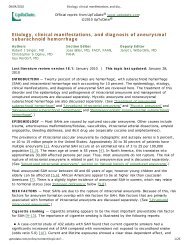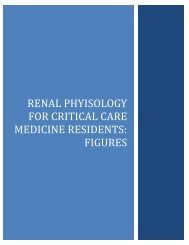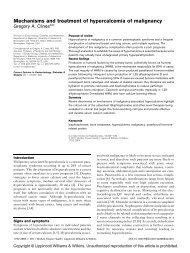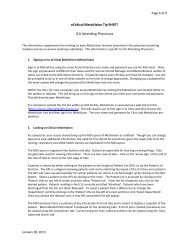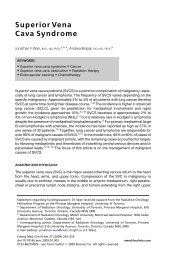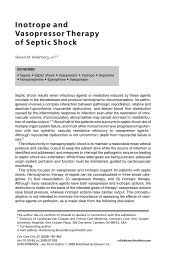Capnographic Waveforms in the Mechanically Ventilated Patient
Capnographic Waveforms in the Mechanically Ventilated Patient
Capnographic Waveforms in the Mechanically Ventilated Patient
Create successful ePaper yourself
Turn your PDF publications into a flip-book with our unique Google optimized e-Paper software.
CAPNOGRAPHIC WAVEFORMS IN THE MECHANICALLY VENTILATED PATIENT<br />
range of capnographic possibilities. Smalhout states that<br />
<strong>the</strong> capnogram is <strong>the</strong> ECG of respiration. Just as <strong>the</strong><br />
electrocardiogram is one <strong>in</strong>dicator of cardiac health, <strong>the</strong><br />
capnogram is an important adjunct to assess<strong>in</strong>g respiratory<br />
function. Hopefully, additional research from cl<strong>in</strong>icians<br />
will fur<strong>the</strong>r <strong>the</strong> field and <strong>in</strong>terpretation of capnograms.<br />
REFERENCES<br />
1. American Society of Anes<strong>the</strong>siologists (ASA). Basic standards for<br />
<strong>in</strong>traoperative monitor<strong>in</strong>g; 1999.<br />
2. Wenzel V, Voelckel WG, Krismer AC, Mayr VD, Strohmenger<br />
HU, Baub<strong>in</strong> MA, et al; American Heart Association; European<br />
Resuscitation Council. [The new <strong>in</strong>ternational guidel<strong>in</strong>es for cardiopulmonary<br />
resuscitation: an analysis and comments on <strong>the</strong><br />
most important changes.] Anaes<strong>the</strong>sist 2001;50(5):342–357. Article<br />
<strong>in</strong> German<br />
3. Guidel<strong>in</strong>es 2000 for Cardiopulmonary Resuscitation and Emergency<br />
Cardiovascular Care. Part 6: advanced cardiovascular life support:<br />
section 3: adjuncts for oxygenation, ventilation and airway control.<br />
The American Heart Association <strong>in</strong> collaboration with <strong>the</strong> International<br />
Liaison Committee on Resuscitation. Circulation 2000;102(8<br />
Suppl):I95–I104.<br />
4. Society of Critical Care Medic<strong>in</strong>e. Task Force on Guidel<strong>in</strong>es. Recommendations<br />
for services and personnel for delivery of care <strong>in</strong> a<br />
critical care sett<strong>in</strong>g. Crit Care Med 1988;16(8):809–811.<br />
5. American Academy of Pediatrics Committee on Drugs: Guidel<strong>in</strong>es<br />
for monitor<strong>in</strong>g and management of pediatric patients dur<strong>in</strong>g and after<br />
sedation for diagnostic and <strong>the</strong>rapeutic procedures. Pediatrics 1992;<br />
89(6 Pt 1):1110–1115.<br />
6. American Association for Respiratory Care. AARC Cl<strong>in</strong>ical Practice<br />
Guidel<strong>in</strong>e: Capnography/capnometry dur<strong>in</strong>g mechanical ventilation—2003<br />
revision & update. Respir Care 2003;48(5):534–539.<br />
7. American College of Emergency Physicians: Expired carbon dioxide<br />
monitor<strong>in</strong>g. Ann Emerg Med 1995;25(3):441.<br />
8. Fowler WS, Comroe JH Jr. Alveolar gas, method <strong>in</strong> medical research.<br />
Chicago: Year Book; 1950;2:219–226.<br />
9. Peppriell JE, Bacon DR, Lema MJ, Ament R, Yearley CK. The<br />
development of academic anes<strong>the</strong>siology at <strong>the</strong> Roswell Park Memorial<br />
Institute: James O. Elam, MD, and Elwyn S. Brown, MD.<br />
Anesth Analg 1991;72(4):538–545.<br />
10. Sands RP Jr, Bacon DR. An <strong>in</strong>ventive m<strong>in</strong>d: <strong>the</strong> career of James O.<br />
Elam, M.D. (1918–1995). Anes<strong>the</strong>siology 1998;88(4):1107–1112.<br />
11. Elam JO, Brown ES. Ten Pas RH Carbon dioxide homeostasis dur<strong>in</strong>g<br />
anes<strong>the</strong>sia. I. Instrumentation. Anes<strong>the</strong>siology 1955;16(11):876–885.<br />
12. Elam JO, Brown ES. Carbon dioxide homeostasis dur<strong>in</strong>g anes<strong>the</strong>sia.<br />
II. Total sampl<strong>in</strong>g for determ<strong>in</strong>ation of dead space, alveolar ventilation,<br />
and carbon dioxide output. Anes<strong>the</strong>siology 1955;16(11):886–902.<br />
13. Elam JO, Brown ES. Carbon dioxide homeostasis dur<strong>in</strong>g anes<strong>the</strong>sia.<br />
III. Ventilation and carbon dioxide elim<strong>in</strong>ation. Anes<strong>the</strong>siology 1956;<br />
17(1):115–127.<br />
14. Elam JO, Brown ES. Carbon dioxide homeostasis dur<strong>in</strong>g anes<strong>the</strong>sia.<br />
IV. An evaluation of <strong>the</strong> partial rebreath<strong>in</strong>g system. Anes<strong>the</strong>siology<br />
1956;17(1):128–134.<br />
15. Gravenste<strong>in</strong> JS, Jaffe MB, Paulus DA. Capnography: cl<strong>in</strong>ical aspects—carbon<br />
dioxide over time and volume. Cambridge UK: Cambridge<br />
University Press; 2004.<br />
16. Smalhout B. Capnografie (<strong>the</strong>sis) University of Utrecht, The Ne<strong>the</strong>rlands,<br />
Utrecht, The Ne<strong>the</strong>rlands: A Oosthoek Publish<strong>in</strong>g Co; 1967.<br />
17. Smalhout B, Kalenda Z. An atlas of capnography, 2nd ed. Kerckebosche<br />
Zeist, The Ne<strong>the</strong>rlands; 1981.<br />
18. We<strong>in</strong>garten M. Respiratory monitor<strong>in</strong>g of carbon dioxide and oxygen:<br />
a ten-year perspective. J Cl<strong>in</strong> Monit 1990;6(3):217–225.<br />
19. Aiken RS, Clark-Kennedy AE. On <strong>the</strong> fluctuation <strong>in</strong> <strong>the</strong> composition<br />
of <strong>the</strong> alveolar air dur<strong>in</strong>g <strong>the</strong> respiratory cycle <strong>in</strong> muscular capacity.<br />
J Physiol 1928;65:389–411.<br />
20. Fowler WS. Lung function studies. II. The respiratory deadspace.<br />
Am J Physiol 1948;154:405–416.<br />
21. Berengo A, Cutillo A. S<strong>in</strong>gle breath analysis of carbon dioxide records.<br />
J Appl Physiol 1961;16(3):522–530.<br />
22. Fletcher R. The s<strong>in</strong>gle breath test for carbon dioxide (Thesis). Lund,<br />
Sweden; 1980.<br />
23. Fletcher R, Jonson B. Deadspace and <strong>the</strong> s<strong>in</strong>gle breath test for carbon<br />
dioxide dur<strong>in</strong>g anaes<strong>the</strong>sia and artificial ventilation: effects of tidal volume<br />
and frequency of respiration. Br J Anaesth 1984;56(2):109–119.<br />
24. Gravenste<strong>in</strong> JS, Paulus DA, Hayes TJ. Gas monitor<strong>in</strong>g <strong>in</strong> cl<strong>in</strong>ical<br />
practice, 2nd ed. New York: Butterworth-He<strong>in</strong>emann; 1995.<br />
25. Bhavani-Shankar K, Philip JH. Def<strong>in</strong><strong>in</strong>g segments and phases of a<br />
time capnogram. Anesth Analg 2000;91(4):973–977.<br />
26. Pyles ST, Berman LS, Modell JH. Expiratory valve dysfunction <strong>in</strong> a<br />
semiclosed circle anes<strong>the</strong>sia circuit: verification by analysis of carbon<br />
dioxide waveform. Anesth Analg 1984;63(5):536–537.<br />
27. Kumar AY, Bhavani-Shankar K, Moseley HS, Delph Y. Inspiratory<br />
valve malfunction <strong>in</strong> a circle system: pitfalls <strong>in</strong> capnography. Can J<br />
Anaesth 1992;39(9):997–999.<br />
28. Podraza AG, Salem MR, Joseph NJ, Brencley JL. Rebreath<strong>in</strong>g due to<br />
<strong>in</strong>competent unidirectional valves <strong>in</strong> <strong>the</strong> circle absorber system (abstract).<br />
Anes<strong>the</strong>siology 1991;75:A422.<br />
29. Holland R, Webb RK, Runciman WB. The Australian Incident Monitor<strong>in</strong>g<br />
Study. Oesophageal <strong>in</strong>tubation: an analysis of 2000 <strong>in</strong>cident<br />
reports. Anaesth Intensive Care 1993;21(5):608–610.<br />
30. Repetto JE, Donohue PA-C PK, Baker SF, Kelly L, Nogee LM. Use<br />
of capnography <strong>in</strong> <strong>the</strong> delivery room for assessment of endotracheal<br />
tube placement. J Per<strong>in</strong>atol 2001;21(5):284–287.<br />
31. Roberts WA, Maniscalco WM, Cohen AR, Litman RS, Chhibber A.<br />
The use of capnography for recognition of esophageal <strong>in</strong>tubation <strong>in</strong> <strong>the</strong><br />
neonatal <strong>in</strong>tensive care unit. Pediatr Pulmonol 1995;19(5):262–268.<br />
32. Grmec S. Comparison of three different methods to confirm tracheal<br />
tube placement <strong>in</strong> emergency <strong>in</strong>tubation. Intensive Care Med 2002;<br />
28(6):701–704.<br />
33. Katz SH, Falk JL. Misplaced endotracheal tubes by paramedics <strong>in</strong> an<br />
urban emergency medical services system. Ann Emerg Med 2001;<br />
37(1):32–37.<br />
34. Sum-P<strong>in</strong>g ST, Methta MP, Anderton JM. A comparative study of<br />
methods of detection of esophageal <strong>in</strong>tubation. Anesth Analg 1989;<br />
69(5):627–632.<br />
35. Asai T, Sh<strong>in</strong>gu K. Case report: a normal capnogram despite esophageal<br />
<strong>in</strong>tubation. Can J Anaesth 2001;48(10):1025–1028.<br />
36. Li J. Capnography alone is imperfect for endotracheal tube placement<br />
confirmation dur<strong>in</strong>g emergency <strong>in</strong>tubation. J Emerg Med 2001;<br />
20(3):223–229.<br />
37. Asai T, Stacey M. Confirmation of feed<strong>in</strong>g tube position: how about<br />
capnography? (letter) Anaes<strong>the</strong>sia 1994;49(5):451.<br />
38. D’Souza CR, Kilam SA, D’Souza U, Janzen EP, Sipos RA. Pulmonary<br />
complications of feed<strong>in</strong>g tubes: a new technique of <strong>in</strong>sertion<br />
and monitor<strong>in</strong>g malposition. Can J Surg 1994;37(5):404–408.<br />
39. K<strong>in</strong>dopp AS, Drover JW, Heyland DK. Capnography confirms correct<br />
feed<strong>in</strong>g tube placement <strong>in</strong> <strong>in</strong>tensive care unit patients. Can J<br />
Anaesth 2001;48(7):705–710.<br />
40. Burns SM, Carpenter R, Truwit JD. Report on <strong>the</strong> development of a<br />
procedure to prevent placement of feed<strong>in</strong>g tubes <strong>in</strong>to <strong>the</strong> lungs us<strong>in</strong>g<br />
end-tidal CO 2 measurements. Crit Care Med 2001;29(5):936–939.<br />
RESPIRATORY CARE • JANUARY 2005 VOL 50 NO 1 107



